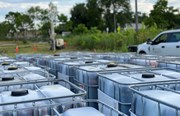5 Questions About Using Low Temperature Thermal Remediation Technology
Although thermal is a powerful remediation technology, it typically requires a lot of infrastructure (e.g., extraction and treatment systems) and energy to produce the heat needed to see results in a short time period. There is a more sustainable alternative, however—low temperature thermal—that can be an effective option for many sites.
If you’d like to learn more about low temperature thermal technology, check out our on-demand webinar, Low Temperature Thermal: The Sustainable Approach.
If you are already familiar with low temperature thermal remediation—or if you attended the webinar but had to leave before the Q&A wrapped up—today’s blog post is for you. We’ll answer some of the questions thermal experts John LaChance and Hillary Easter fielded after their presentation.
What are some of the geological limitations of using low temperature thermal?
There isn’t really a limit on the efficacy of the thermal technology—the challenges we typically face are really engineering puzzles. For example, in bedrock, we obviously can’t use direct push technology (DPT) to install our heaters, but what we can do is use sonic or rotary technology to drill a one-inch hole that we can then insert the heater into.
The question isn’t whether we can use low temperature thermal in lithologies that include bedrock—it’s whether or not such a solution is cost effective.
Is low temperature thermal something that can be used with all soil types, such as glacial till with large, submerged boulders?
Drilling is difficult in lithologies like the one described, but low temperature thermal can work just fine. The boulders heat up similarly to the soil and won’t impact the effectiveness of the remedy. As mentioned before, the real challenge here is the installation of heaters. If the site can be characterized with DPT, the data will allow us to adjust the design and modify the heating grid around the boulders.
What is the maximum depth that low temperature thermal is effective?
We and our partners in Denmark have used thermal conduction heating to depths of 165 ft below grade. There’s no real depth limitation, but there may be practical limitations based on the drilling technologies available.
What is the maximum radius of influence that can be achieved with low temperature thermal?
First, we need to understand how thermal conduction works. Heat moves out radially from the heaters installed in the subsurface, and we position them in such a way that we can effectively get the soil in between the heaters up to the desired temperature in an efficient and timely manner. That’s what allows us to raise and maintain the temperature between heaters—if we had just one heater, the heating effect wouldn’t extend out very far due to heat losses. Similarly, if we had a network of heaters but they were spaced too far apart, we wouldn’t be able to uniformly heat the top or bottom of the treatment zone. Keeping the heaters relatively close to one another prevents heat loss and allows us to get the subsurface to our target temperature in a reasonable amount of time.
So back to the question: what is the radius of influence, or how far apart should we space the heaters? Our analysis shows that, depending on the thickness of the treatment interval and the timeframe available, heaters should be spaced between 14 and 16 feet for optimal efficiency. Spacing at <20 ft is probably the practical limitation, >20ft and the treatment zone will not be uniformly heated to the desired temperature
Is low temperature thermal effective at reducing NAPL?
Low temperature thermal is not the right treatment for extreme sites like those with 20,000 lbs of PCE DNAPL. For low temperature to work on a site like that, we’d have to wait for the DNAPL to dissolve into the water and, while we could enhance that process by applying heat, we’d still be looking at a treatment timeline that lasted decades.
Years ago, John worked on a project in a wetland area contaminated with PCB NAPL. What was interesting was he and his team were able to show that partial natural degradation was occurring and that there was an overall shift from higher chlorinated PCB congeners to lower chlorinated congeners. However, even with all the bugs and conditions in perfect alignment, low temperature thermal is not a good fit for treating PCBs because the process only worked on a portion of the PCB mixture.
However, NAPL that is aerobically degradable—such as petroleum hydrocarbons like gasoline, jet fuel, and diesel—can be an excellent fit for low temperature thermal treatment! LNAPL is typically smeared across the vadose zone and capillary fringe and may even be trapped below the water table, but an assessment can help you determine if you need to add oxygen (e.g., air sparging) and what, if any, kind of amendments you need to add.
In a previous role, John did a lot of work on the natural degradation of NAPL, and one of the things noted was that there is often a temperature increase in aerated portions of the NAPL zones As the bugs chomped on the LNAPL, they released heat that could be detected, monitored and used to estimate LNAPL plume degradation rates. With low temperature thermal, we’re merely facilitating this process.
So can low temperature thermal reduce NAPL? Yes, but whether it’s feasible depends on the remedial goals, expected timeframe and the conceptual site model.
If you’d like to learn more about low temperature thermal remediation, you can watch our on-demand webinar, Low Temperature Thermal: The Sustainable Approach.
Questions? Reach out to John LaChance at [email protected].

